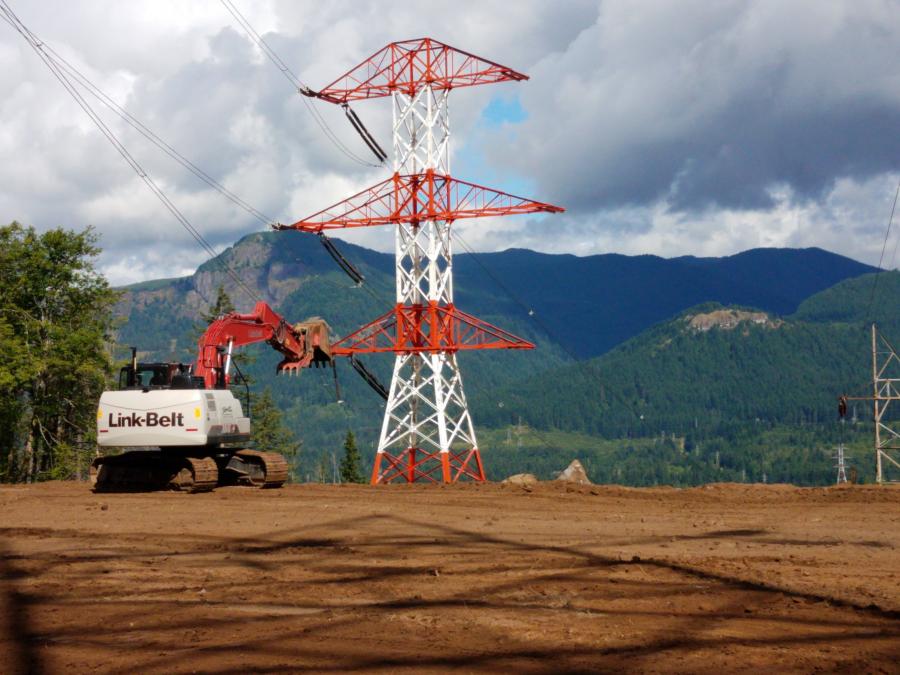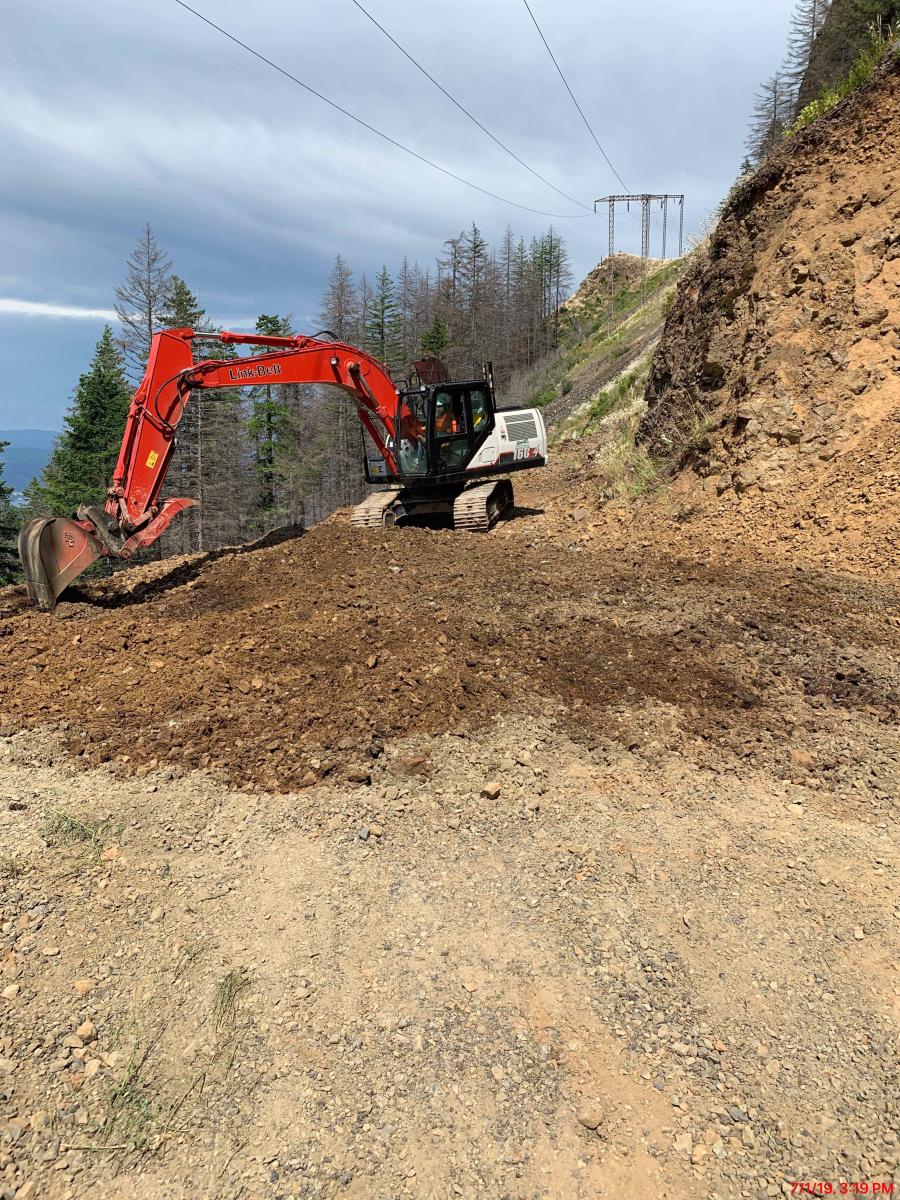The project involves rebuilding portions of BPA’s existing Bonneville-Hood River 115-kilovolt Transmission Line between the Bonneville Powerhouse at Bonneville Dam in Multnomah County, Ore. and BPA’s existing Hood River Substation in Hood River County, Ore.
It's no easy task rebuilding nearly 23 mi. of transmission line in the challenging terrain of Oregon's Pacific Crest Trail. Just to access the $45.7 million project, linemen must endure an hour-long hike or be flown in by helicopter. And yet for some linemen, the Bonneville Power Administration's Bonneville-Hood River Transmission Line Rebuild is a dream job.
"Working on this line rebuild is a challenge that attracts a certain kind of lineman," wrote IBEW president Lonnie Stephenson in an IBEW blog post. "Linemen are up in the mountains, surrounded by waterfalls, doing what they love every day. There's a lot of history behind this job, but there are also facets that make it interesting ... Even to get equipment like excavators, they must be flown in by helicopter. For that reason, these linemen are some of the best in their trade in the world."
According to the BPA website, "This project involves rebuilding portions of BPA's existing Bonneville-Hood River 115-kilovolt Transmission Line between the Bonneville Powerhouse at Bonneville Dam in Multnomah County and BPA's existing Hood River Substation in Hood River County."
BPA will rebuild structures and replace conductor and/or hardware along about 22 mi. of this existing 23-mi.-long transmission line and the existing approximately 400-ft.-long Cascade Locks Tap. BPA also will improve the existing access road and foot trail system that allows BPA to get to and from the Bonneville-Hood River transmission line.
The line has approximately 68 lattice steel pole structures that will be retired along with the associated guying and hardware, according to the website. New engineered steel pole and wood pole structures will be installed and approximately 17 mi. of line will be reconductored."
BPA spokesman Kevin Wingert said, "The challenges are many."
In addition to the rugged terrain, crews with Wilson Construction must work around wild fires, endangered wildlife habitat, including pika, bald eagle and raptors, and in areas — the Columbia River Gorge and Pacific Crest Trail — favored for recreational use. In addition, the transmission line is more than 80 years old. Built during the end of the Depression from 1939 to 1941, the original project was proof that transmission lines could be built anywhere.
In the excerpt "Where Mules Couldn't Go," from "BPA and the Struggle for Power at Cost," author Gene Tollefson quotes Gene White, head of survey operations, "Special towers were designed with no single piece weighing more than 70 pounds. They were carried in by mules wherever possible, and by men where mules couldn't go. We had places where you couldn't get a mule carrying several of the 70 pound pieces, … and 70 pounds was the limit a man could carry or that you could handle by getting a long hand-line across and pulling it across."
Today, the project is the first transmission line at BPA fully utilizing "Human External Cargo (HEC) for performing work on the entire re-build, said Wingert.
"Linemen are safely tied off to the end of a long line that is attached to the belly of a helicopter, where they are then transported from A to B," said Wingert. "Because most of the structures are alongside the cliffs of the gorge, the use of HEC will help linemen gain access to the tower locations swiftly removing the fatigue and time spent that would result if they were to hike to each structure. To minimize environmental impact as well as provide a safe place for the workers to enter and exit the aircraft the contractor will utilize a portable heliport. They will also use helicopters to move material and equipment to the hard to reach sites. The helicopter will also aid in setting structures directly into their respective foundation holes with the help of the linemen guiding and stabilizing the structure."
This also is BPA's first project utilizing micropile foundations and guys, Wingert said. The use of the micropiles will ensure long term stability and strength. The project is slated for completion in 2021.
The helicopters used to transport men (HEC) as well as material including wood poles and steel poles: MD500 helicopter, A-Star helicopter, K-MAX helicopter, Blackhawk helicopter, Huey helicopter, SR-61 helicopter, CH-54 helicopter and Chinook helicopter.
Contractor's Scope
- Rebuild and/or reconductor approximately 17 mi. of the 22.61 circuit miles. Some of the unique aspects of this work include:
- Extremely rugged terrain with several mi. of the line accessible by trail
- Demolition of lattice structures that are more than 80 years old
- Installation of 27 micropile foundations and 11 micropile guy anchors
- Installation of 1 concrete shaft foundation
- Hand dug pole holes with permanent CMP (Corrugated Metal Pipe) footings at 3 structure sites
- Hand dug and rock drilled guy anchors at remote sites, some of which will require repelling in order to access the design location
- Use of medium and heavy lift helicopters to fly out old structures and fly in the new structures at remote sites
- Use of medium and heavy lift helicopters to transport micropile equipment to and from remote sites
- Installation of new fall protection system on new steel pole structures
Completed in the 2019 Season
- Demolition of conductor and structures in mi. 1-to-11 where required
- Installation of 3 micropile foundations and 3 micropile guy anchors
- Installation of 3 engineered steel poles, 9 light duty steel poles, 145 wood poles and 84 guy plate anchors.
- Installation of 12 new fall protection systems on new steel poles.
- Installation of approximately 9.3 circuit mi. of conductor (6 EA wire pull segments).
CEG
Today's top stories




















